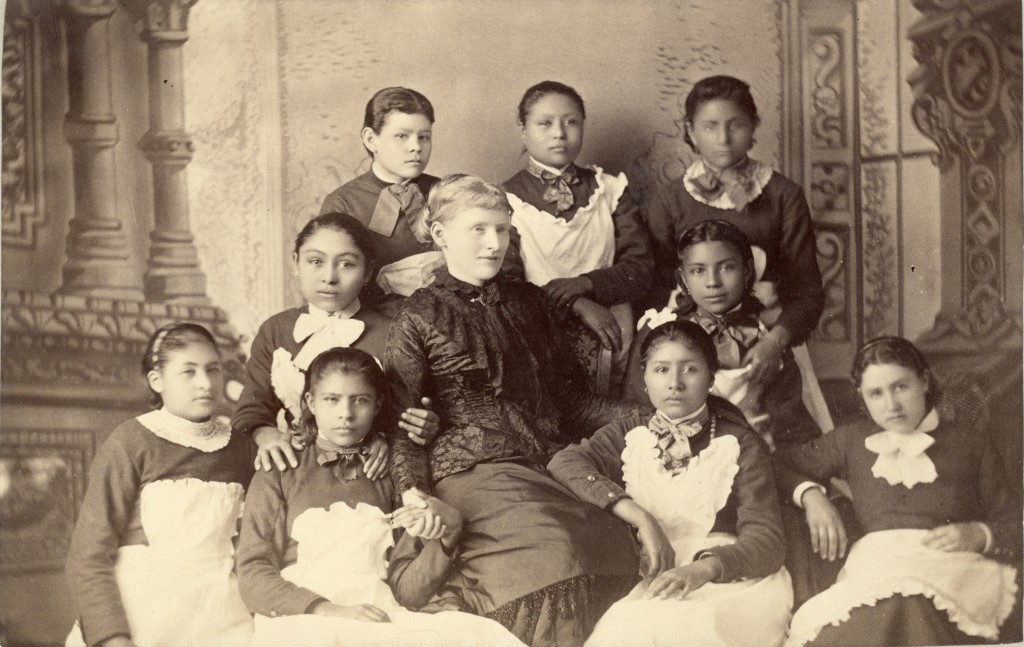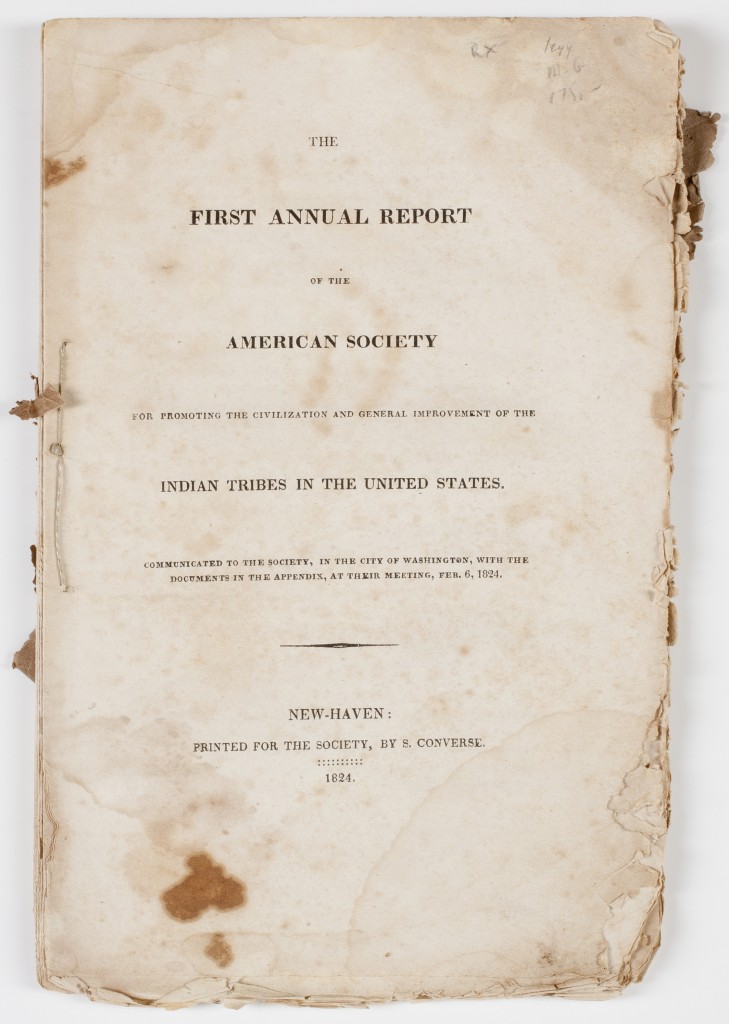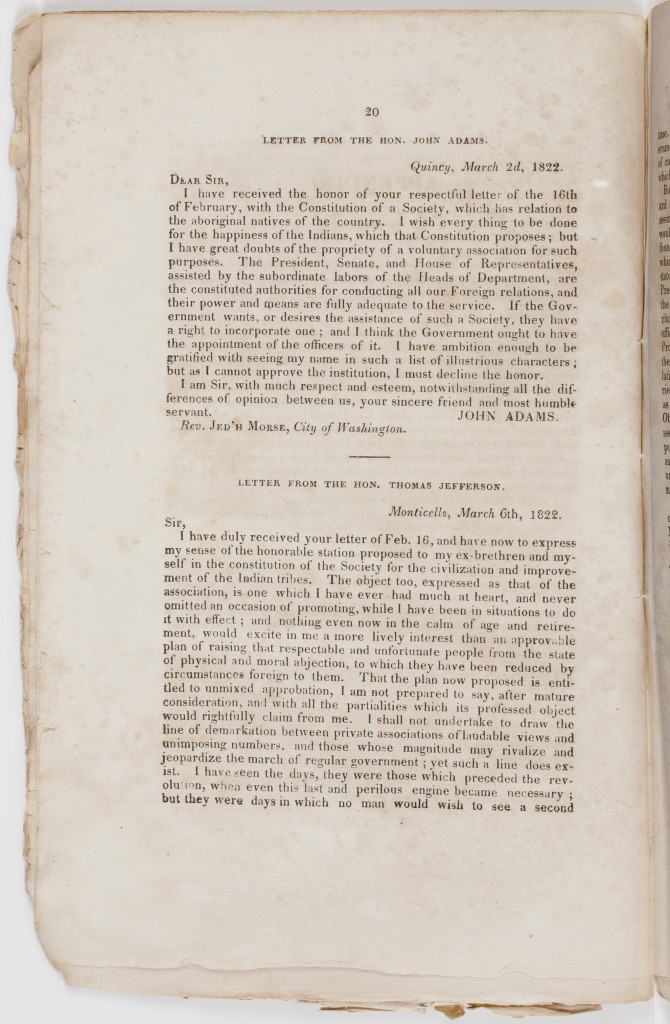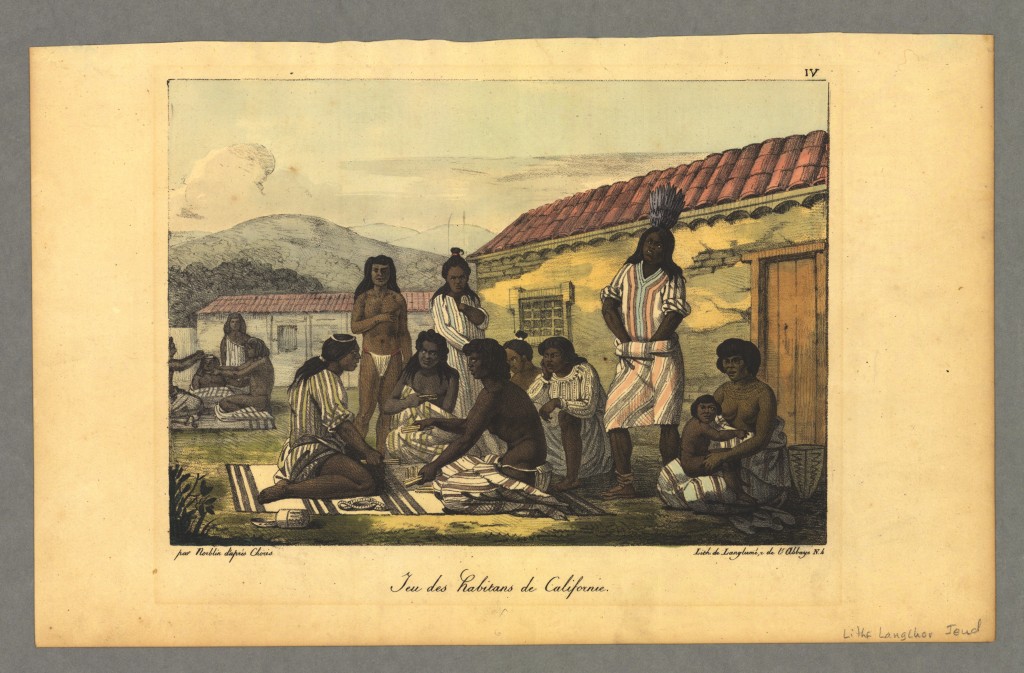Camille Dupuis is a summer page at AAS and a rising senior at Hobart and William Smith Colleges in Geneva, New York. In this post she shares how her time at AAS and her interaction with programs and fellows has piqued her research interests.

At AAS there are thousands of different materials at your disposal and it can be overwhelming to think about where to even begin your research. A few weeks ago AAS held its annual History of the Book in American Culture Summer Seminar and this year the topic was Native American language and writings. I have always been interested in Native American culture (my secret joy as a European History major) and how the American Indians and Europeans clashed when the Europeans arrived and settled on what had been the Indians’ land for hundreds of years. I knew about the Westernization and boarding schools that were intended to integrate Indian children into American society in the late nineteenth century, but I was curious if the American government had tried to assimilate the American Indians earlier in history and if it was in a similar manner to the varying Indian schools in the 1850s and 1860s.
 As I started my research I came across the 1824 First Annual Report of The American Society for Promoting the Civilization and General Improvement of Indians, which had been founded in 1822. The report includes their constitution, the report itself, a list of members (including those who declined to accept membership), and, the part that interested me the most, letters sent back to the Society from the various people they had asked to become members. As I started reading these letters one caught my eye and I realized that my research was going to make a pit stop. It was a letter from Thomas Jefferson giving the reasons why he was declining to become a member of the new society.
As I started my research I came across the 1824 First Annual Report of The American Society for Promoting the Civilization and General Improvement of Indians, which had been founded in 1822. The report includes their constitution, the report itself, a list of members (including those who declined to accept membership), and, the part that interested me the most, letters sent back to the Society from the various people they had asked to become members. As I started reading these letters one caught my eye and I realized that my research was going to make a pit stop. It was a letter from Thomas Jefferson giving the reasons why he was declining to become a member of the new society.
In his lengthy letter, Jefferson brought up many reasons why he could not readily become a member of this society even though he strongly believed in the cause to help the American Indians. In his mind there was no need for this society to be formed as it seemed to be working toward the same ends as the government and intended to include many of the public officials themselves. (For example, the Vice President and the Secretaries of State, Treasury, War, and Navy were to be ex-officio officers in the Society.) He worried that, in the end, the overlap with the government both in people and purpose would only cause collision rather than aid. He wondered what a voluntary private organization could do that the government could not, with men that had their personal objectives as their motivation instead of the interests of the people as a whole:
The Government is at this time going on with the process of civilizing the Indians on a plan probably as promising as any one of us could devise; and with resources more competent than we could expect to command by voluntary taxation;…Is it that a plan, originated by a meeting of private individuals is better than that prepared by the concentrated wisdom of the nation, of men not self-chosen, but clothed with the full confidence of the people? Is it that there is no danger that a new authority, marching independently alongside of the government, in the same line, and to the same object, may not produce collision, may not thwart and obstruct the operations of the government, or wrest the object entirely from their hands?
 Most of the men in this society were not elected or chosen by the American people, but rather by their peers, and Jefferson was worried that this civilian organization “marching independently alongside of the government” would end up undermining the government’s efforts. He went on to argue that there comes a time when the revolutionary mindset needs to stop and the government should be left alone to do its job. In the 1820s, when the country was still relatively young, Jefferson was worried that auxiliary private organizations, particularly all-encompassing ones such as this, could shake the still developing foundations of the Republic. Of course, despite Jefferson’s fears of a private organization undermining the government’s policies towards Native Americans, the government itself began to cause conflict when it instituted Indian removal policies in the 1830s and eventually Indian boarding schools in the 1850s; this however, is a story for a different day.
Most of the men in this society were not elected or chosen by the American people, but rather by their peers, and Jefferson was worried that this civilian organization “marching independently alongside of the government” would end up undermining the government’s efforts. He went on to argue that there comes a time when the revolutionary mindset needs to stop and the government should be left alone to do its job. In the 1820s, when the country was still relatively young, Jefferson was worried that auxiliary private organizations, particularly all-encompassing ones such as this, could shake the still developing foundations of the Republic. Of course, despite Jefferson’s fears of a private organization undermining the government’s policies towards Native Americans, the government itself began to cause conflict when it instituted Indian removal policies in the 1830s and eventually Indian boarding schools in the 1850s; this however, is a story for a different day.
Another aspect of the Society that thoroughly upset Jefferson was the overwhelming proportion of Society members that were also clergymen. He worried that the opinions “both as to purpose and process” of such a large majority of like-minded individuals would always outvote that of the others in the society, such as the public officials included. This would give clergymen and missionaries more influence when determining policies towards the Native Americans, such as whether or not schools should be opened on reservations or the children sent away to Indian boarding schools.

When I mentioned this concern to one of our current fellows (who himself is working on religious conversions in the nineteenth century), he gave me a completely different perspective to think about…“religious ambition,” or the desire to spread one’s religion to others. As we talked he told me Jefferson was considered an “infidel” and did not hold much ground with orthodox religion. This made me think that it was not just the amount of clergy in the Society that worried him, but also the religious ambition this society would fuel. In civilizing the Indians, the Society also wanted them to become part of the religion that was celebrated in the Western world, namely Christianity. Given that Jefferson was not an adherent to orthodox Christianity, it is probable that he did not want Christianity to gain more members in the newly “civilized” Indians, giving it that much more influence in the Western world.
It is easy to find many different messages and clues as to what Jefferson is trying to convey in this letter, just as it is extremely easy to become sidetracked when doing research. You never know what you will find in the materials held at AAS. There is something new to discover every day – all you have to do is start searching.

One thought on “A Letter from Thomas Jefferson on the Plight of Native Americans”